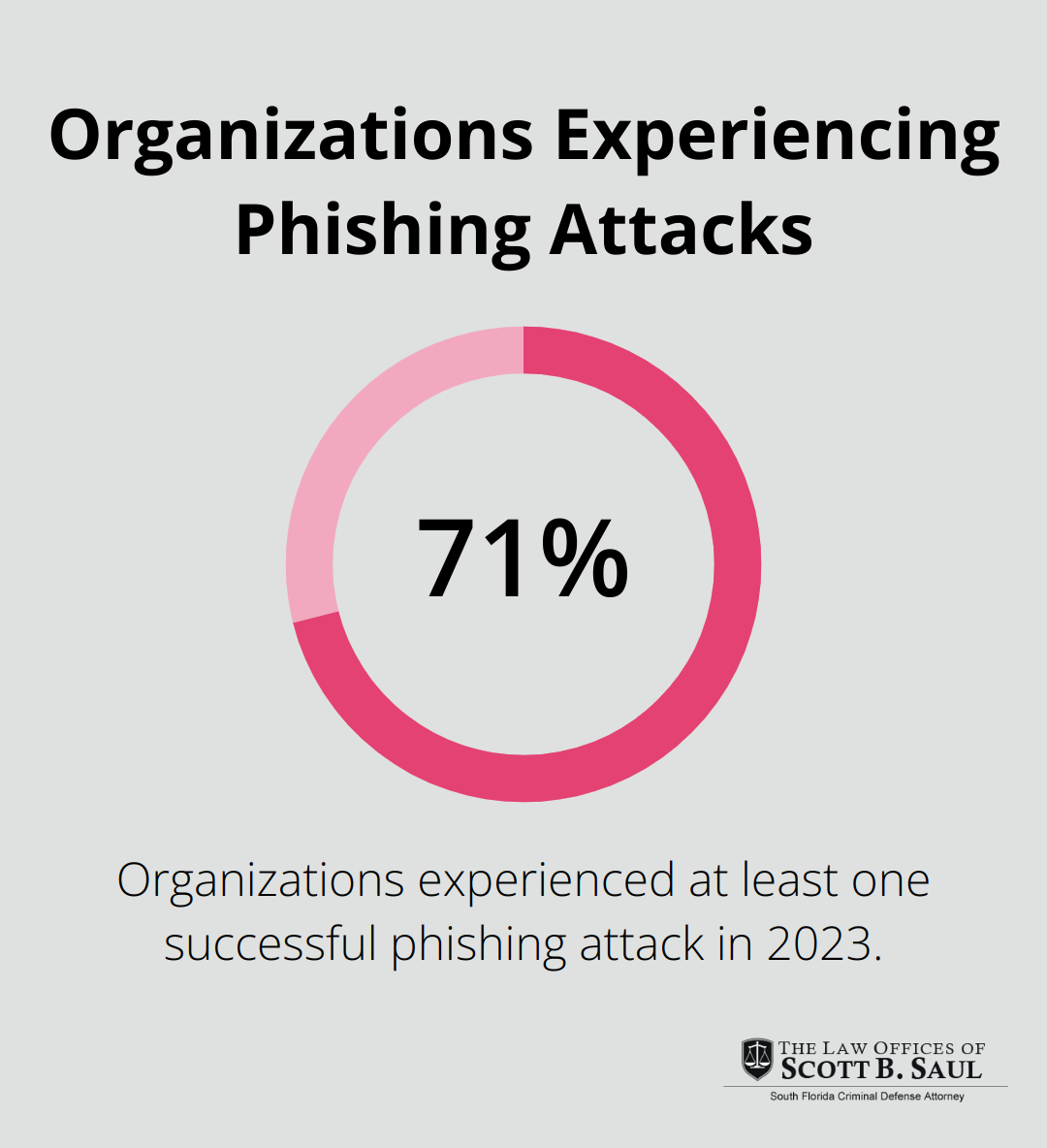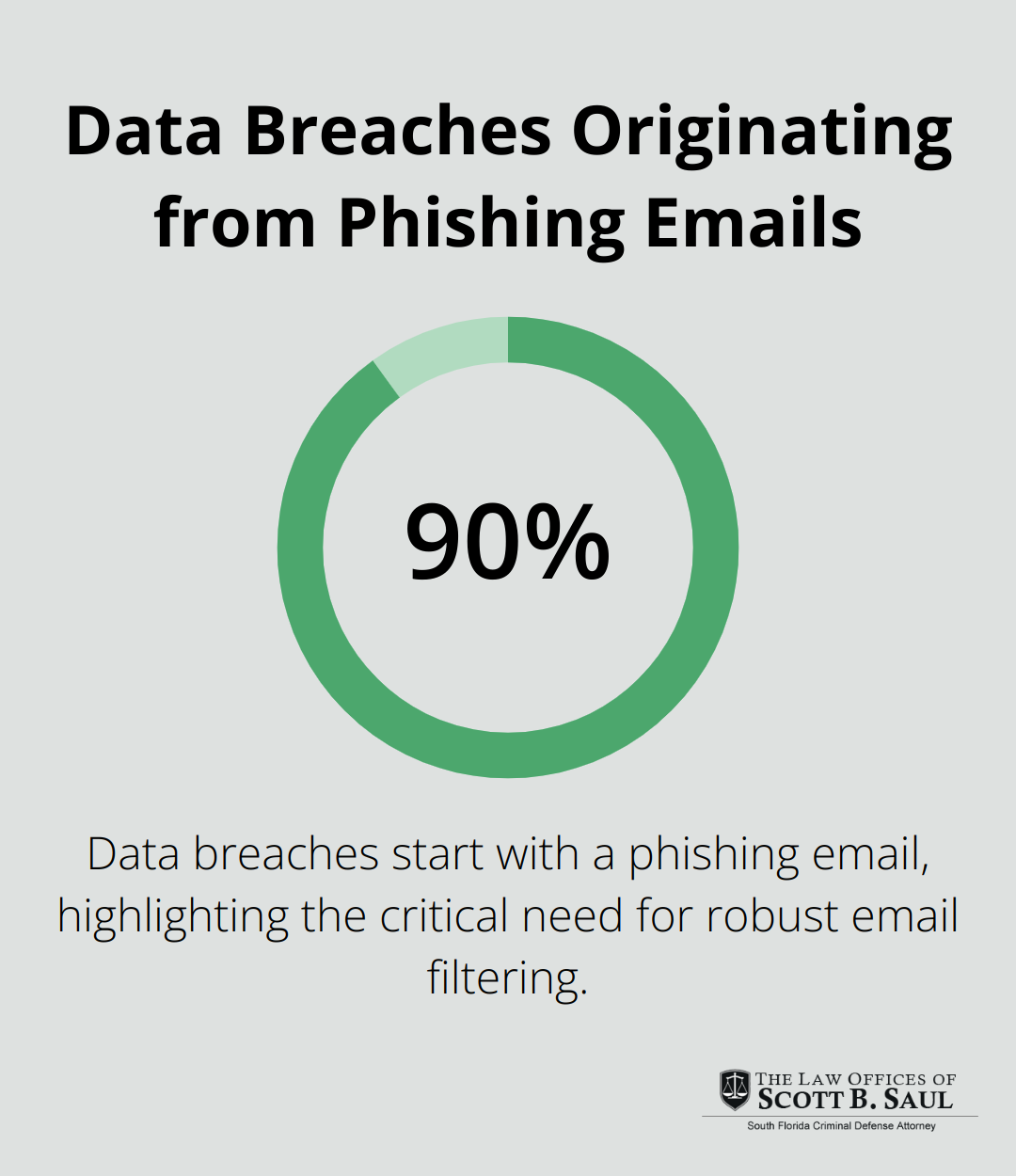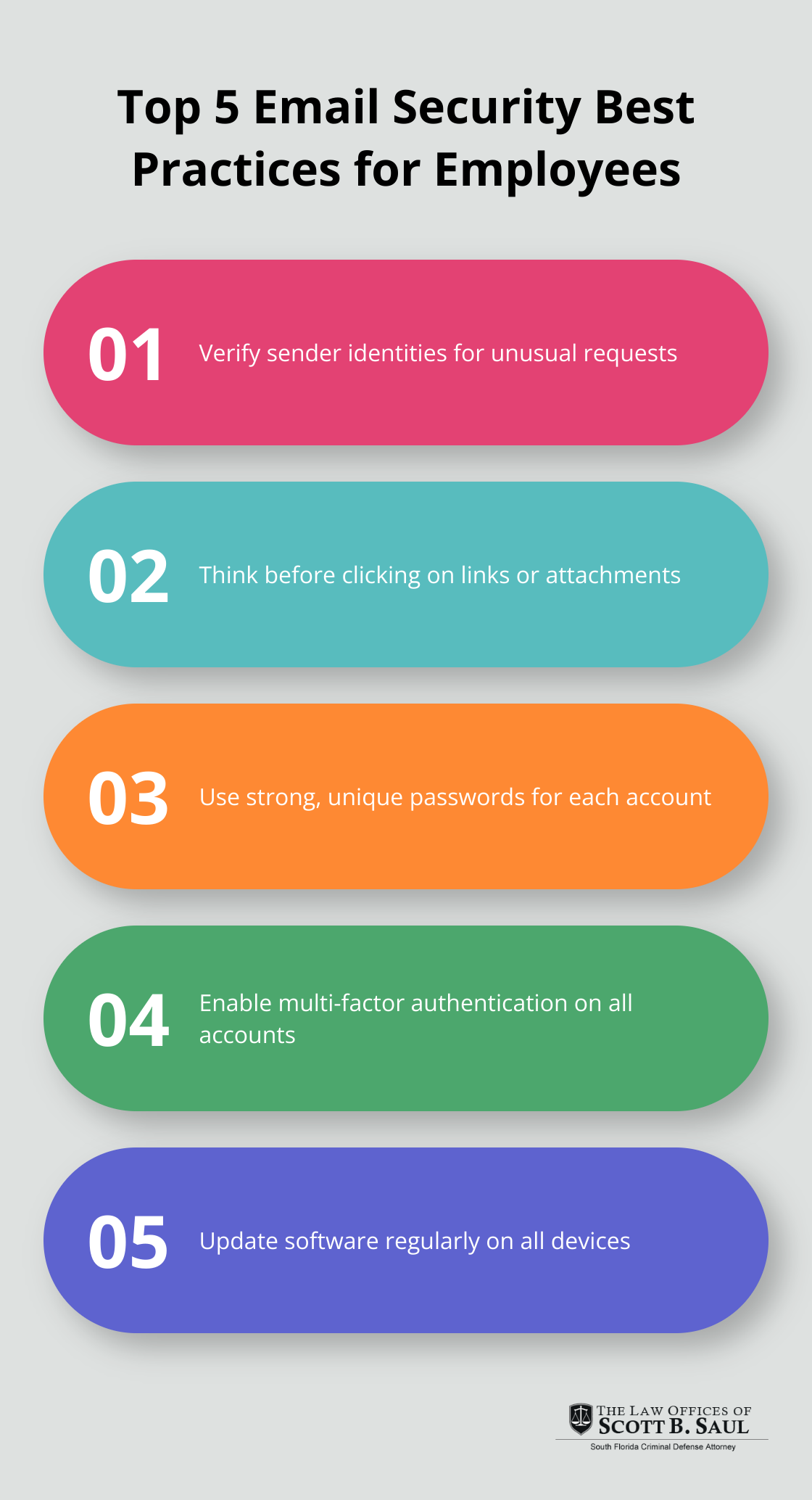How to Protect Your Business from Email Fraud
By : saulcrim | Category : Criminal Defense | Comments Off on How to Protect Your Business from Email Fraud
21st Apr 2025

Email fraud poses a significant threat to businesses of all sizes, potentially leading to financial losses and reputational damage. At Law Offices of Scott B. Saul, we’ve seen firsthand the devastating impact these attacks can have on companies.
This guide will equip you with practical strategies for email fraud defense, helping you safeguard your business against increasingly sophisticated scams. We’ll explore essential technical measures and employee training techniques to fortify your organization’s defenses.
Common Email Fraud Tactics: Protecting Your Business
Email fraud has evolved into a sophisticated threat, endangering businesses of all sizes. The consequences extend beyond immediate financial losses, often resulting in long-term reputational damage and erosion of customer trust.
Phishing: The Deceptive Lure
Phishing remains a prevalent form of email fraud. Cybercriminals craft convincing emails that mimic legitimate sources (banks, social media platforms, or colleagues). These messages often contain urgent requests for sensitive information or include malicious links.
A recent study by Proofpoint revealed that 71% of organizations experienced at least one successful phishing attack in 2023. This statistic underscores the importance of vigilance and employee education about phishing indicators.

Business Email Compromise: A Targeted Approach
Business Email Compromise (BEC) attacks have increased in complexity and frequency. In these schemes, fraudsters impersonate high-level executives or trusted vendors to manipulate employees into transferring funds or sharing confidential data.
The FBI’s Internet Crime Complaint Center reported BEC is a scam targeting businesses working with foreign suppliers. This highlights the financial impact these attacks can have on businesses.
Spoofing: Masquerading as Trusted Entities
Email spoofing involves forging sender addresses to make messages appear as if they’re from a legitimate source. Cybercriminals often use this tactic in conjunction with phishing or BEC attacks to increase their chances of success.
The Far-Reaching Impact on Businesses
The repercussions of email fraud extend far beyond immediate financial losses. Companies may face:
- Long-term reputational damage
- Loss of customer trust
- Potential legal ramifications
A survey conducted by Ponemon Institute found that 65% of IT security practitioners believe their organization’s brand and reputation suffered negative impacts from email fraud attacks. This statistic emphasizes the need for robust email security measures and comprehensive employee training programs.
To shield your business from these evolving threats, you must implement a multi-layered defense strategy. This approach should combine technical safeguards with thorough employee education initiatives. In the next section, we’ll explore practical steps to fortify your organization’s email security and train your staff to recognize and thwart these sophisticated attacks.
Fortifying Your Email Defenses: Technical Safeguards
Leveraging Email Authentication Protocols
Email authentication protocols serve as the first line of defense against spoofing and phishing attempts. Three key protocols work in tandem to verify the legitimacy of incoming emails:
- Sender Policy Framework (SPF): Domain owners specify authorized mail servers.
- DomainKeys Identified Mail (DKIM): Adds a digital signature to outgoing messages.
- Domain-based Message Authentication, Reporting, and Conformance (DMARC): Provides a framework for handling unauthenticated emails.
DMARC deployment is an effective way to limit the spoofing of email from protected domains, although there has been little research on its effectiveness in reducing email-based impersonation attacks.
Enhancing Email Filtering and Gateway Security
Advanced email gateways and spam filters act as powerful guardians against malicious messages. These tools use machine learning algorithms and real-time threat intelligence to identify and quarantine suspicious emails before they reach user inboxes.
Modern email security solutions offer features such as:
- Sandboxing: Executes potentially harmful attachments in a controlled environment.
- URL rewriting: Checks links for malicious content at the time of click rather than delivery.
A study by Cisco found that 90% of data breaches start with a phishing email. The implementation of robust email filtering can significantly reduce this risk, protecting organizations from potential financial and reputational damage.

Implementing Multi-Factor Authentication
Multi-factor authentication (MFA) adds an extra layer of security to email accounts. It makes unauthorized access much more difficult, even if attackers obtain login credentials.
MFA typically requires users to provide two or more verification factors to access their account:
- Something they know (password)
- Something they have (smartphone)
- Something they are (biometric data)
While the ideal goal is to achieve 100% protection, currently only 28% of users have enabled MFA, and these users are still targeted by attackers.
Regular Security Audits and Updates
Conducting regular security audits helps identify vulnerabilities in email systems. These audits should include:
- Review of email server configurations
- Assessment of user access privileges
- Evaluation of current security measures
Regular updates to email servers, security software, and other related systems ensure protection against the latest threats. Organizations should establish a schedule for these updates and audits to maintain a strong security posture.
The implementation of these technical safeguards creates a strong foundation for email fraud prevention. However, technology alone cannot provide complete protection. The next chapter will explore how to complement these measures with comprehensive employee training, creating a human firewall against email threats.
How Employees Become Your Best Defense Against Email Fraud
Spotting the Red Flags
Email fraud prevention requires more than technical safeguards. Your employees play a vital role in protecting your business from cyber threats. Train your team to identify these warning signs:
- Urgent requests for sensitive information or money transfers
- Unexpected attachments or links
- Slight misspellings in email addresses or domain names
- Generic greetings or unusual sender behavior
A study by Proofpoint revealed that 84% of organizations experienced at least one successful email-based phishing attack in 2022. This statistic highlights the need for ongoing employee vigilance.
Creating a Security-First Culture
A culture of cybersecurity awareness requires consistent reinforcement and practical application. Implement these effective strategies to instill a security-first mindset:
- Regular simulated phishing exercises: These tests help employees practice identifying and reporting suspicious emails in a controlled environment.
- Reward programs: Recognize and incentivize employees who consistently demonstrate good security practices or report potential threats.
- Clear reporting procedures: Establish and communicate a straightforward process for employees to report suspicious emails or security concerns.
- Leadership involvement: When executives actively participate in security initiatives, it sends a powerful message about the importance of cybersecurity throughout the organization.
Implementing Email Security Best Practices
Equip your employees with practical email security habits:
- Verify sender identities: Encourage staff to confirm unusual requests through a separate, known communication channel.
- Think before clicking: Train employees to hover over links to preview URLs and exercise caution with unexpected attachments.
- Use strong, unique passwords: Implement a password manager to help employees create and maintain complex passwords for each account.
- Enable multi-factor authentication: Make this a requirement for all email accounts and other sensitive systems.
- Update software regularly: Teach the importance of prompt installation of security patches and updates on all devices.

The FBI’s Internet Crime Complaint Center reported that Business Email Compromise scams resulted in a 9% increase in identified global exposed losses between December 2022 and December 2023.
Continuous Education and Adaptation
The landscape of email threats evolves rapidly. Your employee training program should adapt accordingly:
- Schedule regular refresher courses to keep security knowledge current.
- Share real-world examples and case studies of recent email fraud attempts.
- Encourage employees to stay informed about emerging cyber threats through industry newsletters or cybersecurity blogs.
- Conduct periodic assessments to identify knowledge gaps and tailor future training sessions.
Final Thoughts
Email fraud defense requires a combination of technical safeguards and employee training. Organizations must implement robust email authentication protocols, enhance gateway security, and use multi-factor authentication to create a strong technical foundation. Employees play a vital role as frontline defenders against sophisticated email threats, necessitating comprehensive training programs and a security-first culture.
The threat landscape constantly evolves, demanding ongoing adaptation of security strategies. Regular security audits, software updates, and refresher training sessions help maintain effective defenses against the latest email fraud techniques. Businesses should stay informed about emerging threats to protect their financial and reputational well-being.
Law Offices of Scott B. Saul offers expert guidance on email fraud defense and other cybersecurity matters. Our team (with over 30 years of experience in criminal defense) can provide valuable insights and strategies to protect your business interests. Email fraud prevention requires constant attention and adaptation to safeguard your organization effectively.
Archives
- July 2025 (1)
- June 2025 (9)
- May 2025 (9)
- April 2025 (8)
- March 2025 (9)
- February 2025 (8)
- January 2025 (9)
- December 2024 (10)
- November 2024 (5)
- July 2024 (2)
- June 2024 (2)
- May 2024 (2)
- April 2024 (2)
- March 2024 (2)
- February 2024 (2)
- January 2024 (2)
- December 2023 (2)
- November 2023 (2)
- October 2023 (2)
- September 2023 (2)
- August 2023 (1)
- July 2023 (2)
- June 2023 (2)
- May 2023 (2)
- April 2023 (2)
- March 2023 (2)
- February 2023 (2)
- January 2023 (2)
- December 2022 (2)
- November 2022 (2)
- October 2022 (2)
- September 2022 (2)
- August 2022 (2)
- July 2022 (2)
- June 2022 (2)
- May 2022 (2)
- April 2022 (2)
- March 2022 (2)
- February 2022 (2)
- January 2022 (2)
- December 2021 (2)
- November 2021 (2)
- October 2021 (2)
- September 2021 (2)
- August 2021 (2)
- July 2021 (2)
- June 2021 (2)
- May 2021 (2)
- April 2021 (2)
- September 2020 (5)
- July 2020 (4)
- June 2020 (4)
- May 2020 (4)
- April 2020 (5)
- March 2020 (4)
- February 2020 (4)
- January 2020 (4)
- December 2019 (1)
- November 2019 (4)
- October 2019 (4)
- September 2019 (4)
- August 2019 (4)
- July 2019 (5)
- June 2019 (4)
- May 2019 (4)
- April 2019 (4)
- March 2019 (4)
- February 2019 (4)
- January 2019 (4)
- December 2018 (4)
- November 2018 (5)
- October 2018 (5)
- September 2018 (4)
- August 2018 (4)
- July 2018 (7)
- June 2018 (4)
- May 2018 (4)
- April 2018 (8)
- March 2018 (4)
- February 2018 (4)
- January 2018 (4)
- November 2017 (4)
- October 2017 (4)
- September 2017 (4)
- August 2017 (7)
- July 2017 (6)
- June 2017 (4)
- May 2017 (4)
- April 2017 (4)
- March 2017 (4)
- February 2017 (7)
- January 2017 (4)
- December 2016 (7)
- November 2016 (4)
- October 2016 (4)
- September 2016 (10)
- August 2016 (4)
- July 2016 (4)
- June 2016 (4)
- May 2016 (4)
- April 2016 (4)
- March 2016 (4)
- February 2016 (7)
- January 2016 (4)
- December 2015 (5)
- November 2015 (4)
- October 2015 (7)
- September 2015 (4)
- August 2015 (4)
- July 2015 (13)
- June 2015 (9)
- May 2015 (8)
- April 2015 (6)
- March 2015 (4)
- February 2015 (4)
- January 2015 (4)
- December 2014 (4)
- November 2014 (4)
- October 2014 (4)
- September 2014 (3)
Categories
- Adjudication (1)
- Bankruptcy (1)
- Burglary Crimes (3)
- calendar call (1)
- Car Accident (1)
- Criminal Defense (332)
- Cyber Crimes (7)
- DNA (1)
- Domestic Violence (9)
- Drug Crimes (5)
- DUI (12)
- Embezzlement (1)
- Environmental Crimes (4)
- Expungement Law (2)
- Federal Sentencing Law (3)
- Firearm (3)
- Forgery (4)
- General (82)
- Healthcare (3)
- Immigration (1)
- Indentity Theft (1)
- Insurance (5)
- judicial sounding (2)
- Juvenile Crimes (4)
- Manslaughter (4)
- Money Laundering (3)
- Organized Crime (1)
- Racketeering (1)
- Reckless Driving (3)
- RICO (3)
- Sealing and Expunging (2)
- Sex Offense (1)
- Shoplifting (1)
- Suspended Driver's License (1)
- Traffic (4)
- Trending Topics (1)
- White-collar Offenses (1)

